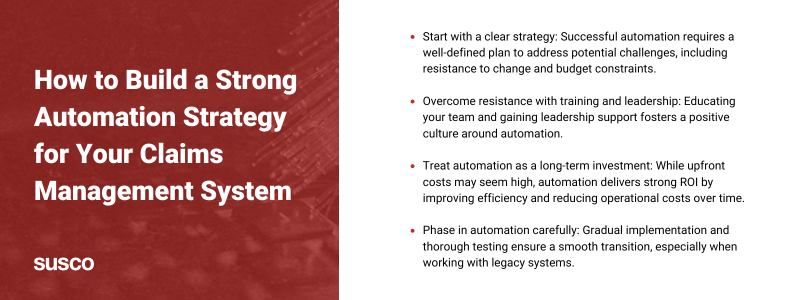
Automation holds the potential to transform claims management, but diving in without a strategy can lead to costly mistakes and unnecessary resistance. IA firms that approach automation with a well-defined plan avoid these pitfalls, ensuring smoother integration and long-term success.
A few practical steps can help develop an effective automation strategy, tackle budget constraints, and overcome resistance to change, empowering your firm to confidently improve claims processing.
Resistance to Change
Resistance to new technology often stems from a reluctance to break away from familiar processes, especially in industries like insurance, where established methods feel comfortable. IA firms must tackle this cultural barrier head-on to ensure successful automation.
Training and education play a crucial role in easing concerns. Empower your team with the skills and knowledge to feel confident using the new system.
Leadership buy-in is equally important. When leaders actively support and engage with the automation process, it sends a clear message that this transition is necessary for growth. Cultivate a positive culture around automation by highlighting how it streamlines workflows and allows staff to focus on higher-value tasks.
Keep communication open, celebrate wins, and involve employees at every stage to foster a sense of ownership and excitement around the change.
Budget Constraints
The initial cost of automation often raises concerns, especially for IA firms working within tight budgets. Investing in new technology may seem risky, but focusing only on the upfront expenses limits the view of its overall value.
Framing automation as a long-term investment
Automation delivers more than short-term efficiencies; it’s a long-term investment that improves productivity, reduces manual errors, and accelerates claims processing.
Highlight automation’s strong ROI, showing how it saves time, reduces operational costs, and ultimately enhances customer satisfaction. This perspective shifts the conversation from immediate costs to future gains.
Tips for Staying Within Budget
To implement automation without breaking the bank, start small. Identify key areas where automation will have the most significant impact and roll it out in phases. Explore scalable solutions that allow your firm to grow into the technology, and consider cloud-based systems that reduce upfront infrastructure costs.
Continuously track and analyze results to ensure your investment aligns with your financial goals.
Measuring Automation Success
Evaluating automation’s effectiveness after implementation is essential to ensuring the expected outcomes are met. Success isn’t just about adopting new tools; it’s about achieving measurable efficiency, accuracy, and overall business performance improvements.
Key Performance Indicators (KPIs) to Track
- Claims processing time: Measure how much faster claims are handled post-automation.
- Error reduction: Track the decrease in manual errors, which can lead to fewer disputes and faster resolution.
- Cost savings: Evaluate reduced labor costs and operational expenses due to streamlined workflows.
- Customer satisfaction: Use client feedback and satisfaction scores to assess improvements in service delivery.
Continuous optimization
Analyze these metrics regularly to understand where automation is excelling and where adjustments might be needed. Automation should evolve with your business, so refining processes as necessary and ensuring the system remains aligned with your goals is important.
Testing new updates and features ensures that your automation strategy remains effective and delivers sustained benefits.
Tracking KPIs and refining your automation process can help maximize your investment and ensure your firm continues to reap long-term rewards from the system.
Transitioning from Legacy Systems
Transitioning from legacy systems to automated processes is often challenging for IA firms. Outdated platforms lack the flexibility to connect with modern automation tools, leading to inefficiencies or disruptions.
However, with the right approach, this shift can be managed effectively.
Challenges of integrating automation with legacy systems
- Legacy systems struggle to adapt to new automation technologies, often causing friction.
- Outdated platforms can disrupt workflows and reduce efficiency during the transition.
Solutions for seamless integration
- Middleware or APIs bridge the gap, allowing legacy systems to communicate with automation tools.
- Collaborating with vendors experienced in integrating older systems helps ensure a smooth transition.
- Identify the best tools for bridging old and new technology to prevent disruptions.
Importance of phased implementation and testing
- Gradual introduction of automation in specific areas limits the risk of widespread disruption.
- Comprehensive testing at each phase ensures the system functions appropriately before scaling up.
- Ongoing adjustments ensure the process remains smooth throughout the transition.
Successfully integrating automation with legacy systems requires a careful, phased approach. By selecting the right tools, working with experienced partners, and testing thoroughly, IA firms can overcome the challenges of legacy systems and move toward a more efficient, automated future.
A solid automation strategy is essential for IA firms looking to streamline claims management. By addressing resistance to change, managing budget constraints, and carefully transitioning from legacy systems, firms can set themselves up for success.
Automation offers long-term benefits beyond cost savings, improving efficiency and client satisfaction. As you move forward, consider how a phased, thoughtful approach to automation could reshape your firm’s future.
Susco has solutions
Are you prepared to overcome these challenges and embrace the potential of a fully automated claims process? The right strategy can transform how you work and serve your clients. Susco is a leading provider of tailored, cutting-edge technology solutions for IA firms. Our solutions unlock the full potential of data and people, leading to efficiency gains throughout the organization.
We can help you build a custom CMS with advanced analytics and reporting capabilities and seamless integration with all your systems.
Start the conversation and propel your move toward a data-driven future.